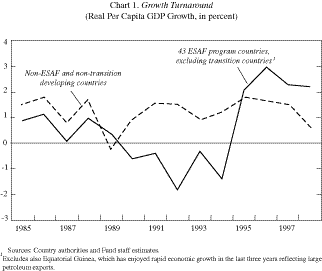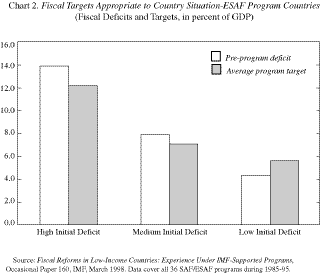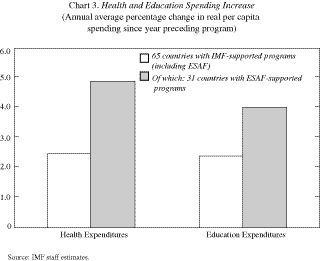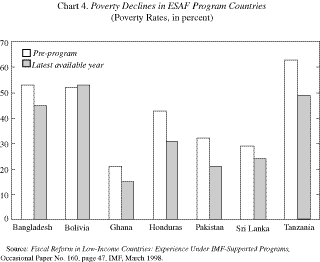|
Status Report on Follow-Up to the Reviews of the Enhanced Structural Adjustment Facility,
August 30, 1999 ESAF Factsheet Summing Up by the Chairman of the Executive Board on Distilling the Lessons from the ESAF Reviews, Executive Board Meeting 98/73, July 8, 1998 External Evaluation of the ESAF Publications on ESAF
|
|
|
|
The IMF's Enhanced Structural Adjustment
Facility (ESAF): Is It Working? September 1999
|
||||||||||||||
|
This experience led some observers to question the effectiveness of the remedies embodied in IMF-supported adjustment programs--especially those backed by the ESAF, the facility established in 1987 through which the IMF provides low-interest loans to poor countries. Some even described these remedies as part of the problem rather than the solution. Partly to examine these concerns, in 1997 the IMF undertook two extensive reviews of the ESAF, including one by a team of external evaluators.1 Both of these reviews endorsed the basic policy approach embodied in ESAF-supported programs, while making a number of suggestions that have strengthened the facility and the programs it supports. Yet the criticisms of ESAF continue, and have been given new voice in the debate surrounding the debt initiative for heavily indebted poor countries (HIPCs), which conditions debt relief on sustained adherence to ESAF-supported programs. This note responds to the key criticisms and explains why we believe that the ESAF contributes positively and effectively to sustainable economic development in the many countries that make use of it.
What the internal review did say was that growth in ESAF countries needed to be faster still, in order to make greater inroads into poverty and begin closing the gap in living standards with the rest of the world. This is now happening. Over the past three years, real per capita incomes in ESAF program countries have been rising at an average 2.5 percent a year, with similar performance in the subsets of countries in sub-Saharan Africa and the franc zone. This is compared with growth of less than 1.3 percent a year in other developing countries (Chart 1). And while progress has not always been smooth, the improvement in performance is, at least partly, a payoff from the accumulated efforts that countries have made over the past ten years to stabilize and reform their economies with ESAF support. Indeed, two of the most consistent reformers--Mozambique and Uganda--have seen their real per capita incomes rise by a cumulative 33 and 43 percent, respectively, since launching their Fund-supported programs in 1987. The review also showed that progress toward external viability is closely linked to growth performance. Policies that foster sustainable growth also promote external viability. This is true even for the many poorest countries that will require, in addition, substantial debt relief of the kind now being delivered under the HIPC Initiative. So the policies work. The challenge is to help countries stay the course of reform, provide an enabling environment for private investment, and boost growth further by pushing ahead more decisively in tackling corruption, cutting red tape, improving the efficiency of government, and investing in people (their health and education) and basic infrastructure. These are the issues on which, in close cooperation with the World Bank and aid agencies, current ESAF-supported programs are focusing.  First, stabilization and long-term growth are consistent goals. The IMF supports prudent macroeconomic policies because we want to promote long-term growth, not in spite of it. The evidence is now overwhelming that high inflation and large fiscal deficits are inimical to sustainable growth and poverty reduction. Inflationary policies do not create wealth and nobody would benefit from the instability such policies would create--least of all the poor. Second, each country's program is tailored to its needs, and programs for countries which already have single-digit inflation and fiscal deficits below about 5 percent of GDP have not typically called for continuing adjustment (Chart 2). In fact, in a number of countries that have achieved stabilization, the Fund is supporting the use of greater aid inflows to promote public investment and social spending, and accommodating stable or even higher budget deficits to that end: recent examples include Benin, Bolivia, Mozambique, Nicaragua, Rwanda, and Uganda. Third, even in programs where public expenditure has had to be reduced to meet the country's budget constraint, social spending is typically protected or even increased (see next point). 
One of the most common criticisms of ESAF-supported programs is that, in the drive to cut budget deficits, education and health spending suffer, thus hurting the poor. This is years out of date. The Fund has responded directly to the criticisms of early ESAF-supported programs, initially by emphasizing the need for program design to take explicit account of the impact of reforms on the most vulnerable groups in society as well as requiring the inclusion of targeted social safety net measures. More recently, the importance of protecting or increasing social expenditures during adjustment has been stressed. Targets for health and education spending are now routinely part of ESAF-supported programs, in some cases with formal conditionality attached. The results should speak for themselves. Health and education spending has increased by an average 4.5 percent a year in real per capita terms during ESAF-supported programs (Chart 3). In the eleven non-transition countries starting ESAF arrangements since end-1997, the programs have targeted increases in health and education spending sufficient to increase their average share of a growing GDP by nearly 0.5 percent in the first year alone. Social spending was targeted to grow at least as fast as GDP in ten of the eleven countries, including five where current spending/GDP was programmed to decline. Social spending in relation to GDP was programmed to fall marginally in only one country--Senegal--but nevertheless to increase by 2 percent in real per capita terms (reflecting rapid growth of GDP). Furthermore, key social "outputs" are also improving on average in ESAF countries: literacy, primary school enrollment, and life expectancy have been rising, and infant mortality declining (Table 1). At the same time, there remains considerable scope for further improvement in the quality of spending, to reduce nonproductive spending, including military spending, and focus more heavily on primary education and preventative health care. The Fund--in close cooperation with the World Bank, where the primary responsibility for these policies lies--is now working to improve statistical information on social policies, and to target social benefits to the most needy and those particularly affected by adjustment policies. 
This criticism is as difficult to refute as it is to substantiate: data on poverty are scarce and almost always several years out of date. But consider the following:
Thus, the general claim that the ESAF makes no contribution to poverty reduction is not supported by the facts. It is, however, true that segments of the poor can in some cases suffer from specific reforms, and we must act to prevent this.6 In line with the recommendations of the external evaluation, the Fund is working with the World Bank (along with UN agencies, the World Health Organization, and regional development banks) to identify problems of this kind as new programs are designed, and to build countermeasures into the programs to protect the poor. It is also true that, beyond simply protecting the poor, we must do more to ensure that they benefit positively from the economic growth that many reforming countries are now experiencing. A key element of this, on which work is now underway with the World Bank, will be to sharpen the focus and effectiveness of social spending in reducing poverty. This will, in turn, require concerted efforts to improve the monitoring of the outputs of social spending, particularly on primary education and basic health care.  It is now almost universally agreed that an appropriate policy environment is a prerequisite for effective use of aid.7 Conditionality is nothing more than a clear definition of what is meant by "appropriate policy environment" in specific programs, providing a direct link between policy performance and the continued flow of financial assistance. It is in the interest of both the borrowing country and the IMF that these terms--the "goal-posts" for assessing program implementation--be spelled out in advance: the country benefits from an assurance that loans will be disbursed if its policy commitments are fulfilled; and the IMF meets its obligation to ensure that the membership's resources are used effectively and can subsequently be repaid. More broadly, the use of conditionality is instrumental in ensuring that scarce resources are directed to those countries in which they can be put to best use. The policy conditions in an IMF-supported program are negotiated between the IMF and the member country. It is, of course, crucial that these negotiations lead to a program that the borrowing government believes in, and is able and willing to implement: in short, one that is "owned." The Fund has taken a number of steps recently to help foster greater ownership of ESAF-supported programs at the level of the government and within society at large:
1 See External Evaluation of the ESAF: Report by a Group of Independent Experts, IMF, 1998, where many of these criticisms are noted; and The ESAF at Ten Years: Economic Adjustment and Reform in Low-Income Countries, by staff of the IMF, Washington DC, 1997 (the internal review). Both documents can be found at www.imf.org. 2All the data referred to in this section exclude transition economies. 3Economic Reform and the Poor in Africa, edited by David Sahn (Oxford: Clarendon Press), 1996. 4"International Development: Is It Possible?" by Joseph Stiglitz and Lyn Squire, in World Vision Discussion Papers, No. 8, Spring 1999. 5"Inflation and Income Distribution: Further Evidence on Empirical Links," by Ales Bulir and Anne-Marie Gulde, IMF Working Paper 95/86, 1995. 6See Social Safety Nets: Issues and Recent Experiences (Washington, IMF, 1998). 7Assessing Aid: What Works, What Doesn't, and Why, World Bank, 1998.
| |||||||||||||||||||||||||||||||||||||||||||